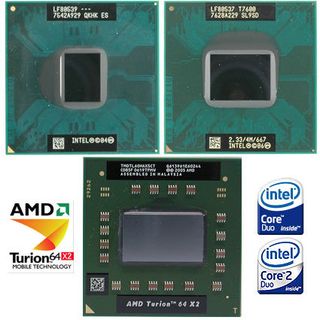Dual Core Notebook CPUs Explored
AMD Turion 64 X2 Meets Intel's Mobile Core 2 Duo

The balance of power in the processor market is very clear: Intel's Core 2 Duo leads, while AMD's Athlon 64 X2 family lags somewhat behind without necessarily being inferior for the average user. But is the situation the same in the notebook space? Both companies offer powerful dual-core processors for portable computers, and we've begun feeding benchmark results into a new Interactive CPU Charts category for mobile processors. You've asked for it, and now you've got it - you can easily compare performance.
Intel maintains a stringent naming scheme for its processors. Former CPU generations with a single processing core were called "Pentium" in the desktop and "Pentium M" in the mobile space (although the latter is based on an entirely different architecture). All modern dual cores for mobile and desktop computers are called "Core Duo" (Yonah core) or "Core 2 Duo" (Merom core).
In contrast, AMD has introduced a different brand for its mobile processors: the Turion 64. While Turion CPUs with a single processing core have been available for almost two years, the dual-core version Turion 64 X2 (Taylor and Trinidad cores) was launched in late spring of 2006; this was shortly before Intel launched its Core 2 Duo micro architecture, and clearly earlier than the mobile Core 2 Duo. Adoption of the Turion 64 X2 was slower, however, as there were fewer system designs available. In addition, Intel has been doing a great job with its Centrino brand, which basically bundles the mobile processor, mobile core logic and mobile wireless solution.
Unfortunately, it has become impossible for non-enthusiasts to decipher AMD's and Intel's model numbers. Both companies follow their own nomenclatures to express clock speed, cache size, features and energy consumption within a single model number. Moving away from gigahertz numbers as the sole figure for performance makes a lot of sense, as clock speed has been only one part of the performance equation in recent years. Unfortunately, the product nomenclatures require some knowledge in order to determine exactly what, for example, a Turion 64 X2 TL56 is.
While there are still many Pentium M and Turion 64 notebooks on the market, not to mention all the low-cost processors that we haven't even mentioned here, the future clearly belongs to dual core processors. Two CPU cores not only translate into better performance, they also provide excellent system responsiveness - this is why we recommend against purchasing a single core system today if you care about a future-proof notebook. Even the energy requirements - which should be as low as possible to achieve long battery runtime - are negligible, because modern multi-core processors shut down transistors or even whole processor segments when they aren't used.
Join our discussion on this topic
Stay on the Cutting Edge
Join the experts who read Tom's Hardware for the inside track on enthusiast PC tech news — and have for over 25 years. We'll send breaking news and in-depth reviews of CPUs, GPUs, AI, maker hardware and more straight to your inbox.
Current page: AMD Turion 64 X2 Meets Intel's Mobile Core 2 Duo
Next Page Mobile Dual Core ProcessorsMost Popular

